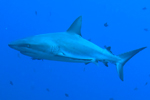Leopard Shark (Triakis semifasciata). Photo by Rhett Butler.
Analyzing the DNA sequences of 4,383 specimens of sharks and rays, researchers have discovered 79 potentially new species, raising both the known diversity of this predacious family and concerns that many species are likely more imperiled than thought. Already 32 percent of open ocean sharks and rays are considered threatened with extinction by the IUCN Red List, due largely to overfishing, finning, bycatch, and prey depletion.
Many of the potentially new species are ‘cryptic’ species, according to the study published in Nature. In other words two species look so similar that scientists have long mistaken them for a single species until the DNA reveals they are not so closely related. This means that some endangered species may be even more threatened when split into two, even smaller, populations.
The scientists were especially surprised by their findings since they only sequenced about half of the world’s 1,200 ray and shark species.
“This will have an impact on what is considered endangered and the fragility of different organisms,” lead author Gavin Naylor with the College of Charleston in South Carolina, told the Scientific American. “These are sentinel species of all sorts of other organisms in the sea which are probably undergoing similar or worse kinds of impacts.”
Experts have begun to warn that the world’s marine ecosystems may suffer a mass extinction. An expert panel last year released a report that argued that the combined impacts of overfishing, pollution, and climate change in the world’s oceans could lead to a widespread collapse in marine life. To deal with these problems the experts recommended immediately slashing carbon emissions, restructuring fisheries towards sustainability, and dealing with sources of pollution, such as plastic and nitrogen run-off.
Related articles
Manta rays tracked by satellite
(05/11/2012) Satellite tracking technology has revealed new insights into the behavior of manta rays, reports the Wildlife Conservation Society (WCS). The findings are published in this week’s issue of the journal PLoS.
Camera traps go under the ocean, seeking sharks
(03/12/2012) Remote camera traps, which have become a hugely important conservation tool on land during the past decade, have now gone underwater. Marine biologists have used underwater video camera traps to compare the population of Caribbean reef sharks (Carcharhinus perezii) in Belize’s protected areas versus fishing areas in a new study in the open-access journal PLoS ONE. Conducted from 2005-2010, the study found that reef sharks benefited significantly from conservation areas.
Costa Rican fishermen plundering Colombian waters for sharks
(10/14/2011) Costa Rican fishermen have killed some 2,000 sharks in Colombian waters off Malpelo island, a protected area renowned for its marine life, reports Colombia Reports.
California governor signs ban on shark fin trade
(10/10/2011) California governor Jerry Brown on Friday signed legislation banning the the importation, possession and sale of shark fins in California.
Marshall Islands creates world’s biggest shark park
(10/03/2011) The Republic of the Marshall Islands has created the world’s biggest shark reserve: so large that all of Mexico could fit comfortably inside. With new legislation, commercial shark fishing is now completely banned in Marshall Islands’ 768,547 square miles (1,990,530 square kilometers) of ocean.
Honduras protects sharks in all its waters
(06/26/2011) Endangered sharks are finding more sanctuaries. Honduras has announced that commercial shark fishing will be banned from its 92,665 square miles (240,000 square kilometers) of national waters. Honduras says the ban, which follows a moratorium on shark fishing, will bring in tourism revenue and preserve the marine environment.
Left alive and wild, a single shark worth $1.9 million

(05/02/2011) For the Pacific island nation of Palau, sharks are worth much more alive than dead. A new study by the Australian Institute of Marine Science (AIMS) has found that one reef shark during its full life is worth $1.9 million to Palau in tourism revenue. Sold for consumption the shark is worth around $108. In this case a shark is worth a stunning 17,000 times more alive than dead.
